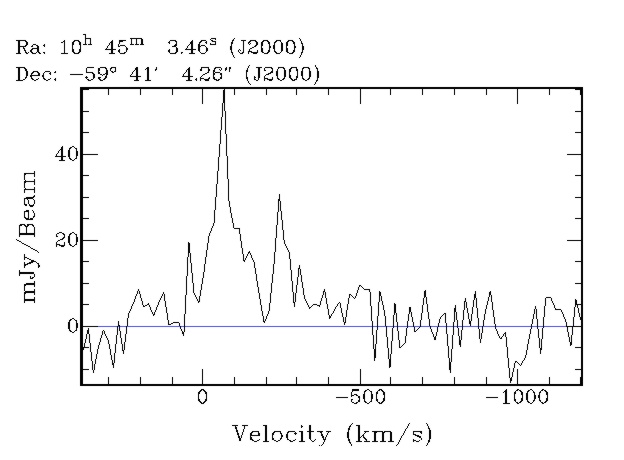12-mm spectroscopy of Eta Carina - a vacation student experience
Every year the tranquil ATCA site is invaded by a bunch of enthusiastic, yet impossibly ignorant vacation students. Thunderstorms were brewing just 100 km west of Narrabri when we started our 12-mm marathon run of Eta Carina. Despite the threats from the weather, our mission got off to a good start. Bob Sault made sure the system was stable and said "Right, I'm off to bed now."; and that was when it hit us. They gave control of one of the best radio telescopes in the world to three clueless vacation students. We were sure we would need to wake Bob several times that night. Fortunately the storms died down and observations went almost without a glitch (except for "ACC04 seems to have died"). The gravest danger we faced all night was from the affectionate kangaroo tailing us from the control room to the lodge.

Figure 1: H70alpha spectrum towards Eta Carina
We aimed to image Eta Carina in continuum and spectral lines, the spectral lines being the hydrogen recombination line H70alpha (18.769 GHz) and the ammonia line (18.808 Ghz). However since we only had antennas 2, 3 and 4 in the 750A configuration, the beam was just too big to resolve emission structure from the Homunculus Nebula around Eta Carina. No ammonia was detected but we did have the first detection (to the best of our knowledge) of the H70alpha line in our spectrum towards Eta Carina (Figure 1). We believe we have detection of the recombination line at -65 km/s and -257 km/s. The velocity resolution of our spectrum is 16 km/s. With data at longer baselines, we should be able to resolve the object and attribute the emission peaks to different parts of the nebula. We would like to thank Bob Sault, Bob Duncan, Jessica Chapman, Diah Setia Gunawan and especially Tony Wong for being our "friend".
Mark Cheung, Jiufu Lim & Arvind Vasan
ATNF vacation students
